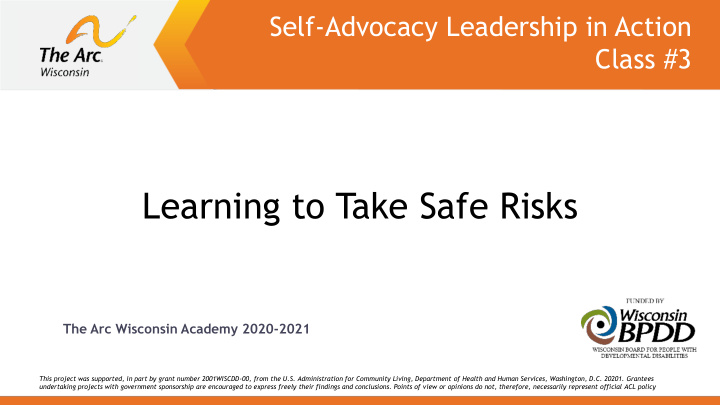



Self-Advocacy Leadership in Action Class #3 Learning to Take Safe Risks The Arc Wisconsin Academy 2020-2021 This project was supported, in part by grant number 2001WISCDD-00, from the U.S. Administration for Community Living, Department of Health and Human Services, Washington, D.C. 20201. Grantees undertaking projects with government sponsorship are encouraged to express freely their findings and conclusions. Points of view or opinions do not, therefore, necessarily represent official ACL policy
Technology Reminders During class you can: • Mute and unmute yourself • Do this if you are not talking • Turn the camera on and off • Use the chat box • View people on the screen. You can see everyone or only person speaking • Show your reactions (give a thumbs up)
Quick Introductions Say your name and tell us if you have or want a pet. Here is an example… My name is Lisa and I have a puppy named Willow.
What are our group rules?
This class will help you learn: 1 2 3 Why taking risks What is a safe risk How to practice helps us learn taking a risk
Homework – • What did you like best about your assignment? Class Two: Future • What did you learn from Planning your assignment?
What looks risky to you?
Darwin
What is a risk? • A risk is doing something new or different or hard • Taking a risk means we’re not sure what will happen • Taking a risk can be scary • Risks can make others around us scared
What is a risk? • Taking a risk can be very rewarding • We learn new things when we take risks • Taking risks builds our confidence • People with disabilities have the right to take safe risks
How could you make a risk safer? • Think carefully before taking a risk • Look at the positives (pros) and negatives (cons) • Practice before taking a risk
When did you take a safe risk?
Families, caregivers and professionals should… • Respect a person who wants to take safe risks • Not be overly cautious • Not stop people from taking safe risks • Support people who want to take safe risks What is Dignity of Risk?
Dignity of Risk
Raise your Hand If anyone has told you… • You can’t do that because you will get hurt • You won’t be able to do that • I will worry about you if you do that • People will make fun of you
My story Did I know what would What do you think happen before I took about the risk I took? the risk? Did I look at the positives and Did I practice? negatives?
Chris Chris would like learn how to ride the bus Chris knows there could be risks Let’s help Chris think about the positives (pros) and negatives (cons)
Chris 1 2 3 What are the Are there any Looking at positive reasons risks (negative positive (pros) and (pros) of Chris reasons) of Chris negative (cons) is learning how to riding the bus? called a risk ride the bus? assessment.
Chris • What do you think Chris should do? • Is learning to ride the bus a safe risk for Chris? • How could he convince others?
Think about your future • What are your dreams for the future? • What would you like your life to look like 10 years from now? • Will you need to take risks to reach your goals? • Do people in your life respect your right to take safe risks?
Remember your SMART Goals
How to take safe risks What did we People should be supported to take safe learn today? risks If we take a risk and it doesn’t work out it is OK
Homework • There are 3 different assignments • You should pick 1 assignment to do between now and the next time we meet • Do not pick more than 1 assignment
Assignment 1 - Directions : Find a picture that shows • A person taking a safe risk. • A safe risk I’d like to take. • How I’ll feel if I can take a safe risk. Assignment 2 - Directions : Fill-in-the-blanks. Homework I’ll feel ________________ when I take a safe risk. I’ll ask __________________ for help to make sure I have a safe environment to take a risk. Assignment 3 Directions : Watch this Assistive Technology video about Stacey https://www.youtube.com/watch?v=hISoNBE_BjE • Read each question. Fill in your answer to each question.
What did you think of this class? GOOD BAD
Recommend
More recommend